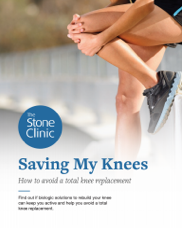ACL repair rehab protocol
General Considerations
- Passive and active range of motion between 30 - 70 degrees for 4 weeks. Brace will set to this range of motion.
*Avoid any extension beyond 30 degrees for 2 weeks post-op. OK to stretch into flexion per patient comfort 2x/day immediately post-op. At 2 weeks post-op, come out of the brace twice a day for extension (straightening) and flexion (bending) range of motion stretching to full range as tolerated. Hold each stretch for 1 minute. Do 2 sets of 1 minute each time (therefore 4 sets of extension per day and 4 sets of flexion per day). Remove brace for stretching.
- Crutches to assist weight bearing progressing to full as tolerated with brace.
- Patient to wear knee brace while sleeping for 4 weeks post-op.
- Soft tissue mobilizations to the incisions to decrease fibrosis and scarring; portals must be completely closed and authorization must be obtained from Dr. Stone (s/p 4 weeks)
- Exercises should focus on early muscular recruitment.
- Begin physical therapy as soon as able for soft tissue mobilization, anti-inflammatory modalities, and general conditioning.
- Patients are given a functional assessment/sport test at 3 months, 6 months, 1 year.
Week 1
- Nurse visit day 2 to change dressing and review home program.
- Icing and elevation as per icing protocol (please see handout for full details).
Manual
- Soft tissue treatments, gentle mobilization to posterior musculature and patella. No portal mobilizations at this time.
Exercises
- Leg raises (30 degrees of knee bend with brace on) (lying, seated, and standing), quadriceps/adduction/gluteal sets, passive and active range of motion exercises within guidelines, well-leg stationary cycling.
- Gait training to normalize walking pattern.
- Balance and proprioception exercises.
Goals
- Decrease pain.
- Weight bearing as tolerated with brace.
- Passive range of motion 30-70 degrees x 4 weeks.
Weeks 2 - 4
- Nurse visit at Day 14 for stitch removal.
Manual
- Continue with effleurage, soft tissue treatments, patellar glides, and passive range of motion.
Exercises
- Incorporate progressive and gentle functional exercises (squats/knee bends, modified lunges, step-ups). Continue with pain control, range of motion, gait training, balance/proprioception and soft tissue treatments. Begin pool workouts after the incisions are healed and with the use of the brace. Begin two-legged aerobic exercises as range of motion allows (VersaClimber, stair machine, upper body ergometer, NordicTrac).
Goals
- Minimal edema, decrease pain.
- Weight bearing as tolerated with brace.
- Range of motion 30-70 degrees x 4 weeks.
Weeks 4 - 6
- M.D. visit at 4 weeks, will discontinue use of post-op brace at that time
- May wean off brace with full range of motion if significant weakness or apprehension is present.
Manual
- Push for full range of motion with emphasis on extension. Continue soft tissue mobilization, joint mobilizations as needed. Initiate scar mobilization once incisions closed.
Exercises
- Increase intensity of all exercises with focus on closed-chain, functional progression. -Stationary and road cycling as tolerated.
Goals
- Range of motion 0-110 degrees.
- Gait no brace, good mechanics.
- Initiate scar mobilization at 4 weeks.
Weeks 6 - 8
Manual
- Continue soft tissue mobilization, joint mobilizations, and scar mobilizations as needed to gain full range of motion.
Exercises
- Continue to increase the intensity of exercises (i.e. stretch cord resistance, adding weight, increasing resistance of aerobic machines).
- Add lateral training exercises.
- Begin to incorporate sport or activity-specific training.
Goals
- Range of motion 0-130 degrees.
Weeks 8 - 12
- Progression of program of increasing intensity to sport-specific tasks and activities of daily living.
- Continue to challenge balance; progress to increased dynamic tasks, BOSU ball, wobble board.
- Progress single-leg activities.
Goals
- Full range of motion.
- Able to descend stairs, double leg squat hold for >1 minute.
- Bike >30 minutes with moderate resistance, Elliptical with interval training, Flutter-style for swimming (no flippers, no breast-stroke kick).
- Initiate sport specific training.
Weeks 12+
- Incorporate bilateral jumping exercises once able to demonstrate adequate strength- start on trampoline or Pilates jump board. Watch for compensatory patterns with take-offs or landings.
- Complete Sports test 1 at 3 months.
- Continue to increase strength, endurance, balance, and sport-specific training drills.
- Patients are not scheduled for another M.D. appointment until 3 - 4 months post-op. At this time, range of motion should be at or near 100 % and any restrictions or concerns should be communicated to our office.
Goals
- Swimming (no fins until > 12 weeks), outdoor cycling.
- Slow Return to sports > 6 months if approved by MD and completion of Sports Test.
NOTE: All progressions are approximations and should be used as a guideline only. Progression will be based on individual patient presentation, which is assessed throughout the treatment process.

